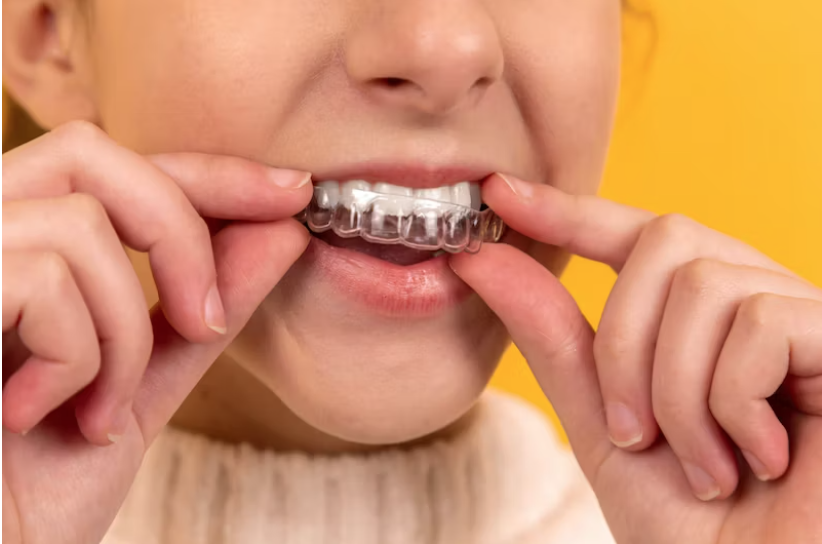Invisalign is rapidly increasing in popularity with both adults and teenagers, with its highly discreet appearance, ease of use, and the benefit of still being able to eat what you want. They are comfortable and provide the orthodontic treatment needed whilst keeping self-confidence under check, however, Invisalign may not always be the best treatment for younger children. Let’s explore a little further.
How Invisalign Works.
Invisalign aligners work by applying controlled force to different teeth, at different stages in your treatment. The process begins by having images taken of your mouth, teeth, and gums, from this, your orthodontist will map out your treatment plan, taking the current and final straightened position of your teeth to map out a plan that gradually aligns your teeth.
Invisalign trays are made from clear, medical-grade thermoplastic, which is strong and smooth, and so very comfortable to wear. Every few weeks, you get a replacement set of aligners, which aims to move specific teeth with each set, creating a controlled and less painful way of aligning your teeth, and gradually working towards your perfect smile.
At What Age Can Children Start to Wear Invisalign?
Children must wait until all their adult teeth have emerged before they can be fitted for Invisalign, this tends to be around 12 to 13 years. Invisalign is a great straightening treatment for more straightforward cases, so if your child has all their adult teeth and they are crowded, have an underbite, overbite, crossbite, open bite, crooked teeth, or gaps between them, then Invisalign may be the perfect option for them, whilst also remaining discreet and protecting their sensitive emotions at a difficult stage in life.
Compliance & Responsibility.
There is a lot more responsibility that comes with Invisalign compared to fixed braces, one of these being that Invisalign aligners need to be worn between 20 and 22 hours per day to be effective, and as they are removable, that leaves children responsible for ensuring they are removed before eating, cleaned and replaced, whilst also ensuring they are not damaged or lost in the process.
Possible Alternatives.
If your child has a more severe dental issue, then they may not be suitable for Invisalign treatment and may need to go down the more traditional route of fixed braces. Some children don’t have the self-awareness and insecurities of an adult so it may not be an issue for them to wear braces that are visible. However, if this is an issue there are options such as ceramic braces which consist of clear or tooth-coloured brackets and wires, or lingual braces which are fixed to the backs of the teeth.
Invisalign First Aligners: What you Need to Know.
Invisalign has a new treatment called Invisalign First which is suitable for 6 to 10 years old and aims to improve children’s smiles as they grow. Invisalign claims that orthodontists are able to see at this age any future issues that may need early treatment and address the unique needs of growing children before they develop.
Invisalign First aims to create a positive experience for children when it comes to dental treatment and they are designed to treat a variety of teeth straightening issues in growing children such as crowding, spacing, and narrow dental arches. Other benefits of Invisalign First include:
- They are designed for comfort with no possible irritation caused by brackets and wires.
- They are removable meaning that it’s easier for children to keep on top of oral hygiene and limit dietary restrictions.
- They are less noticeable than traditional braces, which can be a significant confidence boost for self-conscious children.
Considerations of Invisalign for Children.
As mentioned previously, the nature of Invisalign leaves a lot of responsibility in the child’s hands and requires them to wear them consistently and care for them properly. Invisalign can also be more expensive than traditional braces so it’s important to weigh the benefits against the cost and consider your budget. Lastly, not every child is a candidate for Invisalign, so a thorough evaluation by an orthodontist is necessary to determine if Invisalign is the best option for your child.
Invisalign in Chorley: How Chorley Orthodontics can Help.
If you are in the process of seeking orthodontic treatment for your child, come and speak with your expert orthodontist in Chorley. At Chorley Orthodontics, we can provide you with the advice and support you need to ensure that your child receives the best possible care for their specific needs.
It may be that they are suitable for Invisalign, or it may be that they need a stronger form of treatment to get them the smile of their dreams, whichever treatment is needed, you can be sure that together we will do what is best for you and your child.
Book a free consultation today with your specialist orthodontist in Chorley.




